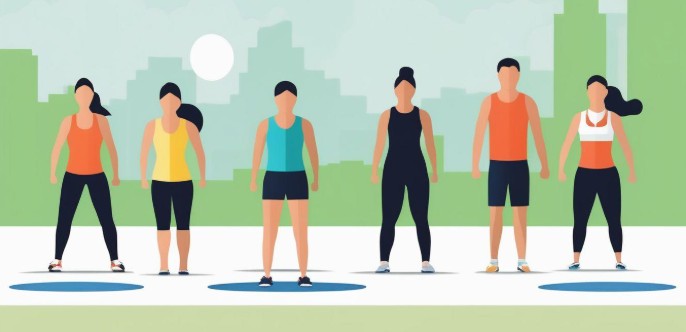How Physical Fitness Became One of Recovery’s Most Powerful Tools
How Physical Fitness Became One of Recovery’s Most Powerful Tools
Your body remembers everything.
Every late night, every poor decision, every moment of stress or celebration gets written into your cellular memory. And when someone struggles with addiction, their body carries those stories too, often in ways that go far deeper than we realize.
The good news?
Your body also has an incredible capacity to heal, rebuild, and transform when given the right support.
This is where fitness enters the picture, not as a superficial add-on or something to worry about “later,” but as a fundamental tool that can reshape the recovery experience.
- Exercise isn’t about achieving a certain look or hitting arbitrary performance goals during this phase of life.
- It’s about reconnecting with your body, rebuilding trust in yourself, and creating new neural pathways that support the person you’re becoming.
- If you or someone you care about is navigating the challenging terrain of recovery, understanding the connection between physical fitness and sustained sobriety might change everything.
Let’s explore why movement matters so much, how to approach fitness during recovery, and what makes physical activity one of the most underutilized tools in the fight against addiction.
The Science Behind Exercise and Recovery
The relationship between physical activity and addiction recovery isn’t just motivational speaker talk or feel-good nonsense.
It’s backed by solid neuroscience that reveals how profoundly exercise impacts the same brain systems affected by substance abuse.
Here’s where exercise becomes crucial. Physical activity also triggers dopamine release, along with endorphins, serotonin, and other neurotransmitters associated with mood regulation and pleasure. While the effect is more subtle than what drugs provide, it’s also:
- Healthier
- Sustainable
- More rewarding
- Comes without the devastating consequences
- Positively impacts other aspects of your life
Regular exercise essentially helps retrain the brain’s reward system, providing a natural source of feel-good chemicals that can ease cravings and improve mood.

Starting Where You Are, Not Where You Think You Should Be
If you’re reading this and thinking about incorporating fitness into your recovery or supporting someone who is, let’s address the elephant in the room: starting an exercise routine while navigating early sobriety can feel overwhelming. You’re already dealing with physical withdrawal symptoms, emotional turbulence, potential health complications from substance use, and the massive life changes that recovery demands. Adding “start working out” to that list might seem impossible.
This is precisely why the approach matters so much.
Fitness during recovery isn’t about training for a marathon or achieving aesthetic goals. It’s about gentle, consistent movement that supports your healing without adding stress or unrealistic expectations.
Start ridiculously small. We’re talking a ten-minute walk around the block, some gentle stretching in your living room, or a beginner yoga video on YouTube. The goal isn’t intensity or duration. It’s about establishing the habit of moving your body and beginning to rebuild that mind-body connection that addiction often severs.
Consider the social component. Group fitness classes, recovery-focused running clubs, or simply walking with a supportive friend can provide accountability and connection.
Many people in recovery struggle with isolation, and movement-based activities offer natural opportunities for healthy social interaction.
The Challenges Nobody Talks About
Being honest about the obstacles helps you prepare for them rather than being blindsided. Recovery is hard enough without unrealistic expectations about how fitness will fit into the picture.
Physical limitations from substance use are real.
Years of drug or alcohol abuse take a toll on the cardiovascular system, liver, kidneys, and virtually every organ system.
Some people enter recovery with significant health problems that limit what types of exercise are safe or appropriate. Working with healthcare providers to understand your specific situation and any necessary modifications is essential, not optional.
Motivation fluctuates wildly during recovery. Some days you’ll feel energized and ready to move. Other days, getting out of bed feels like climbing Everest. This is normal. The goal isn’t perfect consistency but rather returning to movement after difficult periods rather than giving up entirely.
Body image issues often surface during recovery.
Many people used substances to cope with discomfort about their bodies, and removing that coping mechanism can bring those feelings flooding back.
Others gained or lost significant weight during active addiction and feel disconnected from their physical appearance. Approaching fitness from a health and feeling perspective rather than an appearance focus helps navigate this minefield.
Creating a Sustainable Fitness Practice That Supports Long-Term Recovery
Once you’ve established basic movement habits, the next phase involves creating a more structured approach that continues supporting recovery long-term.
This doesn’t mean you need a complicated workout plan or expensive equipment. It means being intentional about how fitness fits into your broader recovery strategy.
Variety prevents boredom and works different aspects of physical fitness.
Combining cardiovascular exercise, strength training, and flexibility work creates a well-rounded program that addresses different health needs.
This might look like walking three days a week, bodyweight strength exercises twice a week, and yoga or stretching on remaining days.
Progressive overload, applied gently, keeps your body adapting and improving. This doesn’t mean constantly pushing to exhaustion. It means gradually increasing duration, frequency, or intensity as your fitness improves. Adding five minutes to your walk, doing one more repetition of an exercise, or trying a slightly more challenging yoga pose represents progress without overwhelm.
Recovery-specific programs exist in many communities, offering fitness opportunities designed specifically for people navigating sobriety. These programs understand the unique challenges and provide supportive environments where you don’t have to explain your situation or feel judged. They often incorporate peer support, trauma-informed practices, and modifications for various health conditions.
The connection between getting professional support for addiction and incorporating fitness becomes clear when you consider comprehensive treatment approaches. Quality recovery programs recognize that healing happens on multiple levels simultaneously. Mental health support, medical care, behavioral therapy, and physical wellness all intertwine to create sustainable recovery. For those in the Portland area seeking comprehensive care that addresses all dimensions of healing, exploring options for addiction recovery in Portland can connect you with programs that integrate physical wellness into their treatment philosophy, understanding that your body’s healing is inseparable from your overall recovery journey.
The Mind-Body Connection in Recovery
Beyond the biochemical benefits, exercise cultivates something equally important: the mind-body connection that addiction often destroys. Substance abuse teaches you to override your body’s signals, to ignore discomfort, hunger, exhaustion, and pain in pursuit of the next high.
Recovery requires relearning how to listen to your body and respond to its needs appropriately.
Movement practices that emphasize this connection, like yoga, tai chi, or mindful walking, can be particularly powerful during recovery.
These activities require you to pay attention to physical sensations, breath, and the present moment. This mindfulness component supports recovery by strengthening your ability to sit with discomfort without immediately reaching for a substance to make it go away.
- Building physical strength translates to psychological empowerment.
- Each workout completed, each goal achieved, each moment you chose movement over staying stuck becomes evidence that you’re capable of hard things.
- This confidence spills over into other areas of recovery, reinforcing your belief that lasting change is possible.
The routine and structure that regular exercise provides cannot be overstated.
Many people in early recovery struggle with how to fill time previously spent using or recovering from substance use. Exercise creates positive structure, gives you something to plan for and look forward to, reduces inflammation, and provides a sense of purpose (BI) during a phase of life that can feel directionless.

Moving Forward
If you’re in recovery or supporting someone who is, remember that fitness isn’t about perfection or impressive achievements.
It’s about showing up for yourself, moving your body in ways that feel good, and gradually rebuilding the physical foundation that supports lasting sobriety.
- Start small, be patient with yourself, and recognize that every step forward matters, even when progress feels slow.
- Some days, your workout will be incredible, and you’ll feel powerful and alive.
- Other days, a ten-minute walk will be your victory, and that’s equally valid.
- The journey of recovery asks so much of you. It requires courage, commitment, and daily choices to prioritize your healing.
- Adding movement to your recovery toolkit doesn’t make the journey easy, but it does make it more manageable. Your body is on your side, ready to support your transformation if you’re willing to support it in return.
Physical fitness won’t cure addiction. No single approach does. But as part of a comprehensive recovery plan that includes professional treatment, peer support, therapy, and lifestyle changes, it becomes a powerful ally. It helps you feel better in your body, manage stress more effectively, sleep more soundly, and build the physical and mental resilience that long-term recovery requires.
You’ve already taken the hardest step by acknowledging the need for change.
Each day in recovery is an act of courage. Letting movement become part of that journey means giving yourself another tool, another source of strength, and another reason to believe that the life you’re building in sobriety is worth every challenging moment.
Your body has been through a lot. It’s time to treat it with the compassion and care it deserves, one workout, one walk, one mindful breath at a time.

